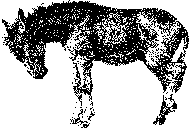 Fowl Talk by
Fowl Talk byHerbert William Weekes
Herbert William Weekes (fl. 1864 – 1904) was a well-known British genre and animal painter of the Victorian Neoclassical period who specialized in portraying animals in humorous, human-like situations.Contents
Early life and family
Weekes was born ca. 1842 in Pimlico, London, England[1] to a prominent artistic family: the youngest of five children, his father, Henry Weekes, Sr. (1807 – 1877), was a sculptor and Royal Academician; his brother, Henry, Jr. (fl. 1850 – 1884), was also a genre painter known for his animal studies; and his brother, Frederick (1833 – 1920), was an artist and expert on medieval costume and design.
Later life and career
Weekes appears to have used his middle name, William, for all but formal purposes. He lived and worked for most of his life in London, at 21 Oppingdon Road, Primrose Hill. In 1865, he married Caroline Anne Henshaw (born ca. 1844), of Hammersmith.
Known as an animal and genre painter of the Victorian Neoclassical style, his work was popular, and helped expand 19th century animal painting from its traditional role of simply recording beasts into a way of reflecting human life. He was greatly influenced by one of the foremost animal painter of the nineteenth century, Sir Edwin Henry Landseer.
Weekes contributed illustrations for the The Illustrated London News in 1883, and exhibited extensively in various London and provincial galleries. His works were well received - although not by everyone: a contemporary wit described his paintings as “Weekes' Weak Squeaks”.
His works were alternatively signed with the initials 'WW' (sometimes overlaid), 'W. Weekes', 'William Weekes', 'Herbert William Weekes', 'H.W. Weekes', 'H. Weekes', and simply 'Weekes'.








No comments:
Post a Comment